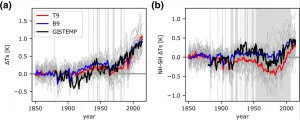(Press-News.org) To investigate humans' impact on freshwater resources, scientists have now conducted the first global accounting of fluctuating water levels in Earth's lakes and reservoirs - including ones previously too small to measure from space.
The research, published March 3 in the journal Nature, relied on NASA's Ice, Cloud and land Elevation Satellite 2 (ICESat-2), launched in September 2018.
ICESat-2 sends 10,000 laser light pulses every second down to Earth. When reflected back to the satellite, those pulses deliver high-precision surface height measurements every 28 inches (70 centimeters) along the satellite's orbit. With these trillions of data points, scientists can distinguish more features of Earth's surface, like small lakes and ponds, and track them over time.
Scientists used these height measurements to study 227,386 water bodies over 22 months and discovered that, from season to season, the water level in Earth's lakes and ponds fluctuates on average by about 8.6 inches (0.22 m). At the same time, the water level of human-managed reservoirs fluctuate on average by nearly quadruple that amount - about 34 inches (0.86 m).
While natural lakes and ponds outnumber human-managed reservoirs by more than 24 to 1 in their study, scientists calculated that reservoirs made up 57% of the total global variability of water storage.
"Understanding that variability and finding patterns in water management really shows how much we are altering the global hydrological cycle," said Sarah Cooley, a remote sensing hydrologist at Stanford University in California, who led the research. "The impact of humans on water storage is much higher than we were anticipating."
In natural lakes and ponds, water levels typically vary with the seasons, filling up during rainy periods and draining when it's hot and dry. In reservoirs, however, managers influence that variation - often storing more water during rainy seasons and diverting it when it's dry, which can exaggerate the natural seasonal variation, Cooley said.
Cooley and her colleagues found regional patterns as well - reservoirs vary the most in the Middle East, southern Africa, and the western United States, while the natural variation in lakes and ponds is more pronounced in tropical areas.
The results set the stage for future investigations into how the relationship between human activity and climate alters the availability of freshwater. As growing populations place more demands on freshwater, and climate change alters the way water moves through the hydrological cycle, studies like this can illuminate how water is being managed, Cooley said.
"This kind of dataset will be so valuable for seeing how human management of water is changing in the future, and what areas are experiencing the greatest change, or experiencing threats to their water storage," Cooley said. "This study provides us with a really valuable baseline of how humans are modulating the water cycle at the global scale."
The researchers' methods relied on a second satellite mission, as well - Landsat, the decades-long mission jointly overseen by NASA and the U.S. Geological Survey. The team used Landsat-derived, two-dimensional maps of bodies of water and their sizes, providing them with a comprehensive database of the world's lakes, ponds, and reservoirs. Then, ICESat-2 added the third dimension - height of the water level, with an uncertainty of roughly 4 inches (10 cm). When those measurements are averaged over thousands of lakes and reservoirs, the uncertainty drops even more.
Although ICESat-2's mission focuses on the frozen water of Earth's cryosphere, creating data products of non-frozen water heights was also part of the original plan, according to Tom Neumann, ICESat-2 project scientist at NASA's Goddard Space Flight Center in Greenbelt, Maryland. Now, with the satellite in orbit, scientists are detecting more smaller lakes and reservoirs than previously anticipated - in this study they detected ponds half the size of the Lincoln Memorial Reflecting Pool.
"We're now able to measure all of these lakes and reservoirs with the same 'ruler,' over and over again," Neumann said. "It's a great example of another science application that these height measurements enable. It's incredibly exciting to see what questions people are able to investigate with these datasets."
INFORMATION:
For more information on ICESat-2, visit http://www.nasa.gov/icesat-2
Climate change is generally portrayed as an environmental and societal threat with entirely negative consequences. However, some sectors of the global economy may actually end up benefiting.
New economic and philosophical research argues that policymakers must consider both the beneficial effects of climate change to "climate winners" as well as its costs in order to appropriately incentivize actions that are best for society and for the environment.
The study by researchers from Princeton University, University College Cork, and HEC Montréal appears to be the first to develop a systematic, ethical framework for addressing climate winners -- as well as those harmed -- using financial transfers.
Their approach, called "Polluter Pays, Then Receives," requires ...
A recent survey of the approximately 274,000 City University of New York (CUNY) students published in the Journal of Urban Health found that the Covid-19 pandemic has taken a toll on their mental health and financial security.
The population-representative survey, conducted by a team of CUNY SPH faculty in collaboration with researchers at Healthy CUNY, found that more than half of CUNY students (54%) reported experiencing depression and/or anxiety in April 2020, at the height of the first wave of the Covid-19 pandemic. Further, they found disturbingly high levels of financial instability and noted that food insecurity and housing worries were strong ...
Injecting hydrogels containing stem cell or exosome therapeutics directly into the pericardial cavity could be a less invasive, less costly, and more effective means of treating cardiac injury, according to new research from North Carolina State University and the University of North Carolina at Chapel Hill.
Stem cell therapy holds promise as a way to treat cardiac injury, but delivering the therapy directly to the site of the injury and keeping it in place long enough to be effective are ongoing challenges. Even cardiac patches, which can be positioned directly over the site of the injury, have drawbacks in that they require invasive surgical ...
CHAMPAIGN, Ill. -- A smartphone app called Harbor, currently under development by researchers at the University of Illinois Urbana-Champaign, teaches young adults how to talk to a peer if they are concerned about that other person's drinking or drug use.
Designed for people ages 18-29, Harbor teaches young adults how they can "act as first responders for their close friends who demonstrate risky substance use behaviors," according to the app's lead developer, social work professor Douglas C. Smith. Smith, the director of the Center for Prevention Research and Development at the U. of I., focuses his ...
Boulder, Colo., USA: GSA's dynamic online journal, Geosphere,
posts articles online regularly. Topics for articles posted for Geosphere this month include "a tale of five enclaves"; evidence
for mantle and Moho in the Baltimore Mafic Complex (Maryland, USA); and the
after effects of the 1964 Mw 9.2 megathrust rupture, Alaska.
From Ordovician nascent to early Permian mature arc in the southern
Altaids: Insights from the Kalatage inlier in the Eastern Tianshan, NW
China
Qigui Mao; Jingbin Wang; Wenjiao Xiao; Brian F. Windley; Karel Schulmann
...
Abstract:
The Kalatage inlier in the Dananhu-Haerlik arc is one of the most important
arcs in the Eastern Tianshan, southern Altaids ...
BROOKLYN, New York, Wednesday, March 3, 2021 - Machine-learning (ML) systems are becoming pervasive not only in technologies affecting our day-to-day lives, but also in those observing them, including face expression recognition systems. Companies that make and use such widely deployed services rely on so-called privacy preservation tools that often use generative adversarial networks (GANs), typically produced by a third party to scrub images of individuals' identity. But how good are they?
Researchers at the END ...
Nature Communications Publishes Paper by Lundquist Institute Investigator Dr. Wei Yan and Colleagues on New Promising Compound for Male Contraceptive Pill
The Lundquist Institute researchers discovered a natural compound that exhibits almost ideal male contraceptive effects in pre-clinical studies
LOS ANGELES (March 3, 2021) -- In a new paper published by Nature Communications, The Lundquist Institute (TLI) Investigator Wei Yan, MD, PhD, and his research colleagues spell out an innovative strategy that has led to the discovery of a natural compound as a safe, effective and reversible male contraceptive agent in pre-clinical animal models. ...
A recent analysis of the latest generation of climate models -- known as a CMIP6 -- provides a cautionary tale on interpreting climate simulations as scientists develop more sensitive and sophisticated projections of how the Earth will respond to increasing levels of carbon dioxide in the atmosphere.
Researchers at Princeton University and the University of Miami reported that newer models with a high "climate sensitivity" -- meaning they predict much greater global warming from the same levels of atmospheric carbon dioxide as other models -- do not provide a plausible scenario of Earth's future climate.
Those ...
Inspired by the eyes of mantis shrimp, researchers have developed a new kind of optical sensor that is small enough to fit on a smartphone but is capable of hyperspectral and polarimetric imaging.
"Lots of artificial intelligence (AI) programs can make use of data-rich hyperspectral and polarimetric images, but the equipment necessary for capturing those images is currently somewhat bulky," says Michael Kudenov, co-corresponding author of a paper on the work and an associate professor of electrical and computer engineering at North Carolina State University. "Our work here makes smaller, more user friendly devices possible. And that would allow us to better bring those AI capabilities to bear in fields from astronomy to biomedicine."
In the context of this research, ...
Researchers have analyzed tracking data for 5,775 birds across 39 species of albatrosses and large petrels -- threatened seabirds whose ranges span many countries and the high seas -- to estimate how responsibility for their protection should be distributed among nations and international organizations. The authors note that albatrosses and large petrels from all breeding countries spend much of their time on the high seas, indicating that effectively managing these waters is of global interest. These estimates are critical to inform ongoing United Nations discussions to design a global treaty for conserving biodiversity in the high seas, beyond national jurisdictions, the authors write. Many species of albatrosses and ...




